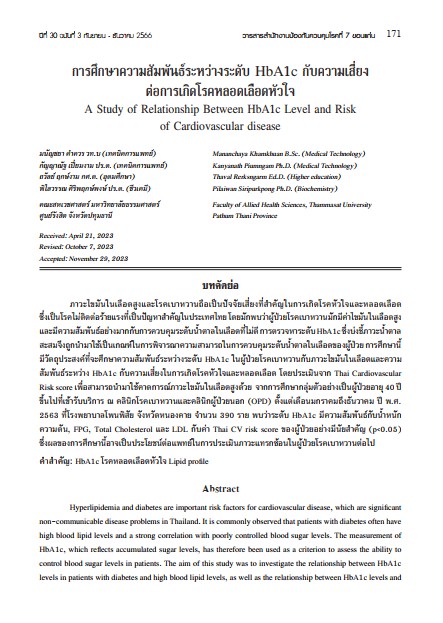การศึกษาความสัมพันธ์ระหว่างระดับ HbA1c กับความเสี่ยงต่อการเกิดโรคหลอดเลือดหัวใจ
คำสำคัญ:
HbA1c, โรคหลอดเลือดหัวใจ, Lipid profileบทคัดย่อ
ภาวะไขมันในเลือดสูงและโรคเบาหวานถือเป็นปัจจัยเสี่ยงที่สำคัญในการเกิดโรคหัวใจและหลอดเลือด ซึ่งเป็นโรคไม่ติดต่อร้ายแรงที่เป็นปัญหาสำคัญในประเทศไทย โดยมักพบว่าผู้ป่วยโรคเบาหวานมักมีค่าไขมันในเลือดสูง และมีความสัมพันธ์อย่างมากกับการควบคุมระดับน้ำตาลในเลือดที่ไม่ดี การตรวจหาระดับ HbA1c ซึ่งบ่งชี้ภาวะน้ำตาลสะสมจึงถูกนำมาใช้เป็นเกณฑ์ในการพิจารณาความสามารถในการควบคุมระดับน้ำตาลในเลือดของผู้ป่วย การศึกษานี้มีวัตถุประสงค์ที่จะศึกษาความสัมพันธ์ระหว่างระดับ HbA1c ในผู้ป่วยโรคเบาหวานกับภาวะไขมันในเลือดและความสัมพันธ์ระหว่าง HbA1c กับความเสี่ยงในการเกิดโรคหัวใจและหลอดเลือด โดยประเมินจาก Thai Cardiovascular Risk score เพื่อสามารถนำมาใช้คาดการณ์ภาวะไขมันในเลือดสูงด้วย จากการศึกษากลุ่มตัวอย่างเป็นผู้ป่วยอายุ 40 ปีขึ้นไปที่เข้ารับบริการ ณ คลินิกโรคเบาหวานและคลินิกผู้ป่วยนอก (OPD) ตั้งแต่เดือนมกราคมถึงธันวาคม ปี พ.ศ. 2563 ที่โรงพยาบาลโพนพิสัย จังหวัดหนองคาย จำนวน 390 ราย พบว่าระดับ HbA1c มีความสัมพันธ์กับน้ำหนัก ความดัน, FPG, Total Cholesterol และ LDL กับค่า Thai CV risk score ของผู้ป่วยอย่างมีนัยสำคัญ (p<0.05) ซึ่งผลของการศึกษานี้อาจเป็นประโยชน์ต่อแพทย์ในการประเมินภาวะแทรกซ้อนในผู้ป่วยโรคเบาหวานต่อไป
เอกสารอ้างอิง
Bureau of Epidemiology, Department of Disease Control. 5-Year National Non-Communicable Disease Prevention and Control Strategic Plan (2017-2021). Bangkok: Emotion Art; 2017.
Boontharika Boonchaisaen. Thai CV risk calculator: An application to assess the risk of cardiovascular and cerebrovascular disease [Internet]. 2018 [cited 2021 April 10]. Available from: https://livewithdrug.com/2018/02/23/thai-cv-risk-calculator-app/
Yamane T. Statistics: an introductory analysis. New York: Harper and Row; 1967.
Sherwani SI, Khan HA, Ekhzaimy A, Masood A, Sakharkar MK. Significance of HbA1c Test in Diagnosis and Prognosis of Diabetic Patients. Biomark Insights 2016; 11: 95-104.
Dave M, Gupta AK, Patel P, Heernath H. Correlation between Fasting Blood Sugar Level, HbA1C Level and Serum Lipid Levels in Type 2 Diabetes Mellitus Patients. Int J Contemp Med Res 2019; 6(7): 26-9.
Schwab KO, Doerfer J, Naeke A, Rohrer T, Wiemann D, Marg W, et al. Influence of food intake, age, gender, HbA1c, and BMI levels on plasma cholesterol in 29,979 children and adolescents with type 1 diabetes--reference data from the German diabetes documentation and quality management system (DPV). Pediatr Diabetes 2009; 10(3): 184–92.
Lien CF, Chen SJ, Tsai MC, Lin CS. Potential Role of Protein Kinase C in the Pathophysiology of Diabetes-Associated Atherosclerosis. Front Pharmacol 2021; 12: 716332.
Singh G, Kumar A. Relationship among HbA1c and lipid profile in Punajbi type 2 diabetic population. J Exerc Sci Physiother 2011; 7(2): 99–102.
Duangrithi D, Wattanasermkit R, Rungwijee S, Khunsom N. Thai CV Risk Score and Primary Prevention in Impaired Fasting Plasma Glucose or Diabetes Mellitus versus Normoglycemia in Patients with Metabolic Syndrome. Int J Prev Med 2020; 11: 139.
Sasisekhar TVD, Shabana S. Can HbA1c act as a surrogate marker for cardiovascular risk? IOSR J Dent Med Sci 2013; 3(4): 39-43.
Wu X, Zhao Y, Chai J, Hao D. The correlation between the Glycated hemoglobin (HbA1c) in non-diabetics and cardiovascular risk factors. Pak J Pharm Sci 2016 Jan; 29(1 Suppl): 315–9.

ดาวน์โหลด
เผยแพร่แล้ว
รูปแบบการอ้างอิง
ฉบับ
ประเภทบทความ
สัญญาอนุญาต
ลิขสิทธิ์ (c) 2024 สำนักงานป้องกันควบคุมโรคที่7 จังหวัดขอนแก่น

อนุญาตภายใต้เงื่อนไข Creative Commons Attribution-NonCommercial-NoDerivatives 4.0 International License.
ความรับผิดชอบ
บทความที่ลงพิมพ์ในวารสารสำนักงานป้องกันควบคุมโรคที่ 7 ขอนแก่น ถือเป็นผลงานทางวิชาการหรือวิจัย และวิเคราะห์ตลอดจนเป็นความเห็นส่วนตัวของผู้เขียน ไม่ใช่ความเห็นของวารสารสำนักงาน ป้องกันควบคุมโรคที่ 7 จังหวัดขอนแก่น หรือ ของกองบรรณาธิการแต่ประการใด ผู้เขียนต้องรับผิดชอบต่อบทความของตนเอง
ลิขสิทธ์บทความ
บทความที่ได้รับการตีพิมพ์จะถือเป็นลิขสิทธิ์ของสำนักงานป้องกันตวบคุมโรคที่ 7 จังหวัดขอนแก่น



